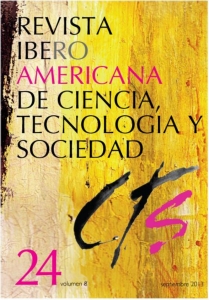Building innovation capabilities in small-scale rural agro-industries of El Salvador
DOI:
https://doi.org/10.52712/issn.1850-0013-635Keywords:
innovation, innovation capabilities, territorial systems of innovation, territorial economic development, small scale rural agroindustry, panela, El SalvadorAbstract
This article analyzes the building of innovation capabilities in small scale family-owned businesses involved in the processing and commercialization of panela -a traditional type of raw, non–refined sugar- in the Central-American context of El Salvador. Although this analysis is focused on one particular associative initiative, ACOPANELA, an entrepreneurship that integrates multiple small trapiches –family-owned businesses-, this article postulates the building of innovation capabilities, in the context of the panela subsector, as one of the small scale agro-industries with a longstanding tradition in El Salvador. The results of this analysis are used to draw lessons as to how innovation capabilities emerge and are developed in this type of associative economic initiatives. Proposals are also presented for strengthening the territorial reach of public and private programs to promote innovation in small scale rural agro-industries and other types of rural SMEs, under the logic of constructing territorial systems of innovation.
Downloads
References
ALFARO ORTEGA, W. y GOMEZ PORTILLO, A. (2008): Diseño de un plan de marketing social para mejorar la imagen de las fábricas de azúcar de El Salvador, Tesis de Licenciatura, El Salvador, Facultad de Economia, Francisco Gavidia University.
AROCENA, R. y SUTZ, J. (2010): “Emerging neoperipheral structures and gardening policies”, en B. Johnson, B. y O. Segura (eds): Systems of Innovation and Development: Central American Perspectives, Costa Rica, Universidad Nacional.
BELL, M. (1997): “Technology transfer to transition countries: are there lessons from the experiences of the post-war industrialising countries?”, en D. Dyker (ed.): The Technology of Transition: Science and Technology Policies for Transition Countries, Budapest, Central European University Press.
BESSANT, J. y RUSH, H. (1995): “Building bridges for innovation: the role of consultants in technology transfer”, Research Policy, 24(1), pp. 97–114.
BLOMQVIST K. y LEVY J. (2006): “Collaboration capability – a focal concept in knowledge creation and collaborative innovation in networks”, International Journal of Management Concepts and Philosophy, 2(1), pp. 31-48.
CARLSSON, B. y JACOBSSON S. (1997): “Diversity creation and technological systems: a technology policy perspective”, en C. Edquist, C. (ed.): Systems of Innovation: Technologies, Institutions and Organisations, London, Routledge, pp. 266- 294.
COHEN, W. M. y LEVINTHAL, D. A. (1990): „Absorptive capacity: a new perspective on learning and innovation”, Administrative Science Quarterly, 35(1), pp. 128–152.
CUMMINGS, A. (2007): Against All Odds: Building Innovative Capabilities in Rural Economic Initiatives in El Salvador, PhD thesis, Aalborg University Aalborg, Denmark.
CUMMINGS, A. (2009): “Social Construction of Learning and Networking Capabilities to Innovative in Rural Economic Initiatives in El Salvador”, Revista Pueblos y Fronteras, 6.
CUMMINGS, A. (2010): “Building innovation capabilities for cashew nut processing in El Salvador”, en B. Johnson, B. y O. Segura, O. (eds): Systems of Innovation and Development: Central American Perspectives, Costa Rica, Universidad Nacional.
CUMMINGS, A. y MENA R. (1999): “Policies from the Perspective of Innovation: The Case of El Salvador”, SUDESCA Research Papers Series, Aalborg University.
EDQUIST, C. y JOHNSON, B. (1997): “Institutions and organizations in systems of innovation”, en C. Edquist. C. (ed.): Systems of Innovation: Technologies, Institutions and Organizations, London, Routledge, pp. 41-63.
ERBES, A., ROBERT, V. y YOGUEL, G. (2010): “Capacities, innovation and feedbacks in production networks in Argentina”, Economics of Innovation and New Technology, 18(8), pp. 719–741.
JOHNSON, B. y LOPEZ, M. (2010): “Systems of innovation and development”, en B.
Johnson y O. Segura (eds): Systems of Innovation and Development: Central American Perspectives, Costa Rica, Universidad Nacional.
KOIVISTO, T. (2005): Developing Strategic Innovation Capability of Enterprises: Theoretical and Methodological Outlines of Intervention, Finlandia, VTT Technical Research Centre of Finland.
LAWSON, B. y SAMSON, D. (2001): Developing innovation capability in organisations: a dynamic capabilities approach, International Journal of Innovation Management, 5(3), pp. 377–400.
MÜLLER, J. (2003): “Global technological transformations – conceptual and methodological framework”, en J. Cuada, J. (ed.): Culture and Environmental Technology Transformation in Developing Countries-transfer or Local Innovation?, Aalborg, Denmark, Department of Development and Planning, Aalborg University.
MÜLLER, J. (2010): “Informal sector systems of innovation”, en B. Johnson, B. y O. Segura (eds): Systems of Innovation and Development: Central American Perspectives, Costa Rica, Universidad Nacional.
OROZCO, J. B. (2004): Innovation and Performance Improvements in the Cooperative Sector, Costa Rica, PhD thesis, Department of Development and Planning, Aalborg University, Denmark.
RIMISP (2008): Estudio de caso de productores de panela: Cooperativa ACOPANELA, El Salvador, RIMISP.
ROBERT, V., YOGUEL, G., COHAN, L. y TAJTENBERG, L. (2010): “Innovation Strategies and Employment Dynamics in Argentinian Productive Networks”, Paper presentado en Globelics Conference, November 1-3, 2010, Kuala Lumpur.
SPENDER, J.C. (1996): “Making Knowledge the Basis of a Dynamic Theory of the Firm,” Strategic Management Journal, vol. 17 Winter Special Issue.
United Nations Development Program (UNDP) (2010): Report on Human Development in El Salvador 2010: From Poverty and Consumerism to the People´s Wellbeing. Proposals for a New Development Model, El Salvador, UNDP.
Downloads
Published
How to Cite
Issue
Section
License
Copyright (c) 2024 CC Attribution 4.0

This work is licensed under a Creative Commons Attribution 4.0 International License.
All CTS's issues and academic articles are under a CC-BY license.
Since 2007, CTS has provided open and free access to all its contents, including the complete archive of its quarterly edition and the different products presented in its electronic platform. This decision is based on the belief that offering free access to published materials helps to build a greater and better exchange of knowledge.
In turn, for the quarterly edition, CTS allows institutional and thematic repositories, as well as personal web pages, to self-archive articles in their post-print or editorial version, immediately after the publication of the final version of each issue and under the condition that a link to the original source will be incorporated into the self-archive.











